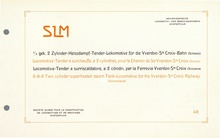YSteC G 4/4 4
| YSteC G 4/4 4 | |
|---|---|
|
Aliénor
|
|
| Numbering: | YSteC 4 OSE 54 |
| Number: | 1 |
| Manufacturer: | SLM |
| Year of construction (s): | 1911 |
| Retirement: | 1947 YSteC approx. 1980 OSE |
| Axis formula : | D. |
| Gauge : | 1000 mm ( meter gauge ) |
| Length over buffers: | 9274 mm |
| Fixed wheelbase: | 2600 mm |
| Total wheelbase: | 4100 mm |
| Empty mass: | 31.1 t |
| Service mass: | 38.9 t |
| Friction mass: | 38.9 t |
| Top speed: | 45 km / h |
| Indexed performance : | 500 hp |
| Driving wheel diameter: | 1010 mm |
| Number of cylinders: | 2 |
| Cylinder diameter: | 410 mm |
| Piston stroke: | 550 mm |
| Cylinder pressure: | 12 atm |
| Boiler overpressure: | 12 atm |
| Number of heating pipes: | 121 |
| Heating pipe length: | 3550 mm |
| Grate area: | 7 m 2 |
| Superheater area : | 23 m 2 |
| Water supply: | 3 m 3 |
| Fuel supply: | 700 kg of coal |
| Locomotive brake: | Spindle brake, counter pressure brake |
| Train brake: | Hardy type vacuum brake |
| Speedometer: | Hasler |
| Coupling type: | Rolling buffer with screw coupling |
The G 4/4 4 of the Chemin de fer Yverdon-Ste-Croix (YSteC) was a four-axle tank locomotive for pure friction operation. The machine, which was commissioned in 1911, was scrapped in 1947 and sold to the Thessalian Railways (gr. Σιδηρόδρομοι Θεσσαλία ) in Greece . Today it is number 54 as a memorial at Larisa train station .
history
To replace and reinforce the aging rolling stock, the YSteC was able to put new rolling stock into operation in 1911. It was a 4/4 coupled steam locomotive, two four-axle passenger cars with open platforms BC 4 14-15, two baggage cars with mail compartments FZ 52-53 and two freight cars.
The four-axle locomotive was given the number 4 at YSteC and the name "Aliénor", named after the play of the same name by René Morax . The "Aliénor" remained a one-off and the only 4/4 coupled, narrow-gauge steam locomotive in Switzerland without running axles. With the return and recommissioning of HG 4/4 of the Furka mountain route, the latter takes over this position. The G 4/4 4 was available from SLM for CHF 56,800.
construction
The locomotive G 4/4 4 looked like the almost identical old AB G 4/5 7-8 and was similar in terms of dimensions, but the running axle was missing . It received a new superheater and worked with a superheated steam twin machine. The second and fourth axes could be moved sideways. The third axle was designed as a drive axle . Even when the fire box was propped up, the locomotive ran restlessly, which was not least due to the overhanging design and the total length of 9274 millimeters. This resulted in considerable wear on the wheel flanges and rails. There was a sand and steam dome on top of the kettle. The latter was equipped with Pop safety valves.
With an output of 500 hp, a pulling force of 6600 kg and a lower fuel consumption of 10.13 kg per kilometer, the G 4/4 4 far surpassed the older G 2 × 2/2 1–3 mallet steam locomotives.
Use at the YSteC
As the most powerful of the four machines, the G 4/4 4 often took over the heavy passenger and freight trains. Despite the G 2/3 + 2/2 Mallet locomotives with the numbers 26–28 bought from the Rhaetian Railway (RhB) to replace the G 2 × 2/2 , the "Aliénor" remained the most powerful and most popular locomotive of the YSteC.
With the completion of the electrification of the YSteC in 1947, the G 4/4 4 became dispensable. After it was scrapped, it came to the Thessalian Railways.
Use in Greece
To compensate for the loss of locomotives after the Second World War and the Greek Civil War , the Thessalian Railways took over the YSteC G 4/4 4 together with the locomotives G 3/4 203-205 , HG 3/3 1055 and 1058 of the Swiss Federal Railways in 1947 .
The locomotive, which is still ranked as number 4, was used by the Thessalian Railways on the narrow-gauge lines from Volos to Larisa , Kalambaka and on the Volos port railway. For this purpose, the pulling and pushing device was modified and equipped with side buffers.
In 1955, the Thessalian Railways were part of the Greek State Railways Sidirodromoi Ellinikou Kratos (SEK). Locomotive 4 was given the new number 54. In 1973, the SEK went into what is now the State Railroad Organismos Sidirodromon Ellados (OSE). Under the regime of the OSE, the locomotive, still used as number 54, was parked in Volos around 1980. For a long time it was then intended for a railway museum to be opened in Volos. In 2005 the exterior of the machine was refurbished and erected as a memorial in front of the Larisa train station .
literature
- Alfred Moser : The steam operation of the Swiss railways 1847-2006. 7th updated and supplemented edition. Published by the Swiss Association of Railway Amateurs.
- Michel Grandguillaume, Gérald Hadorn, Sébastien Jarne, Jean-Louis Rochaix: Voies étroites du Jura Vaudois. Editions La Raillère, Belmont, Lausanne 1988, ISBN 2-88125-006-7 .




